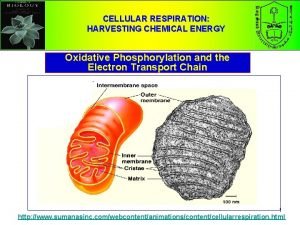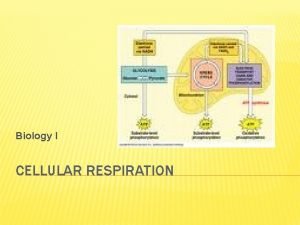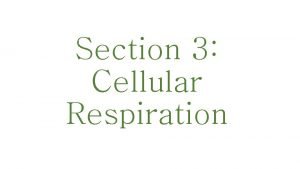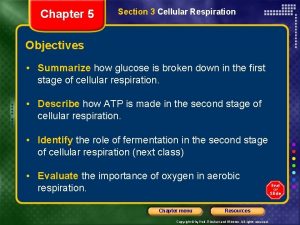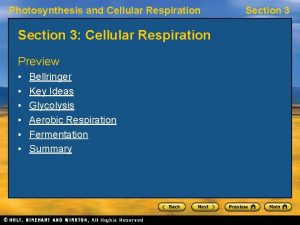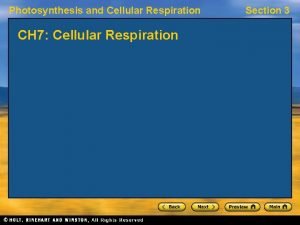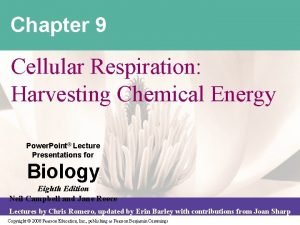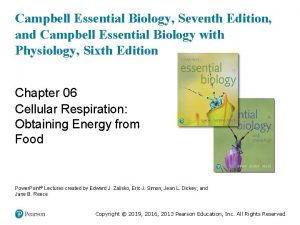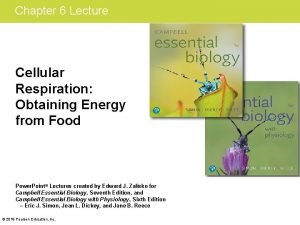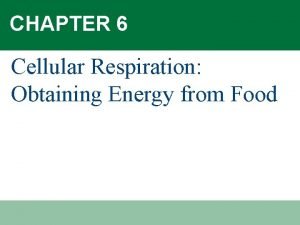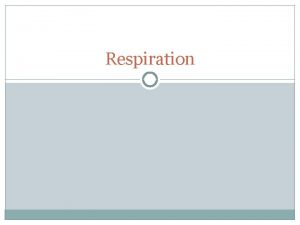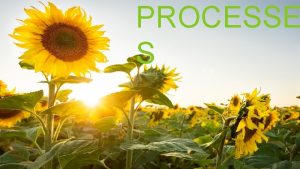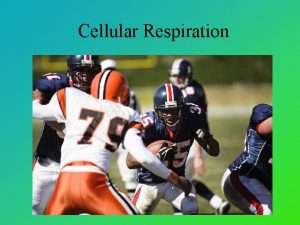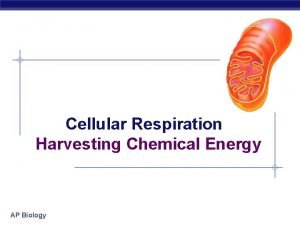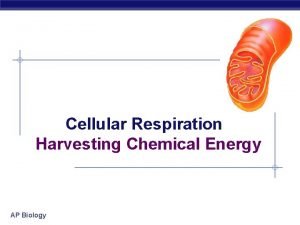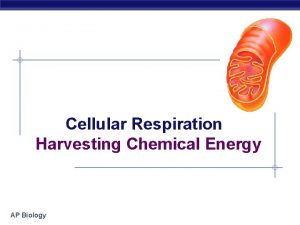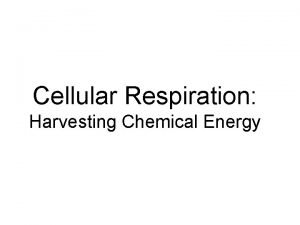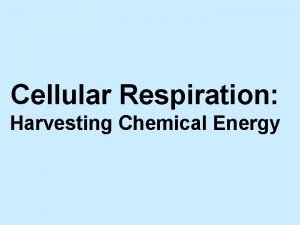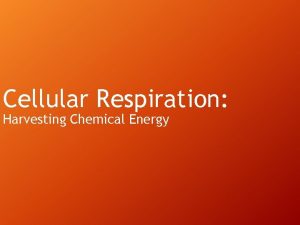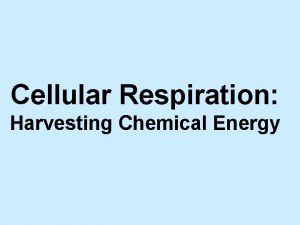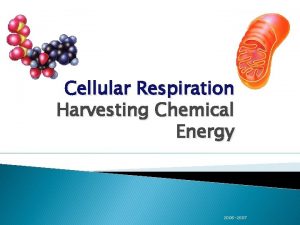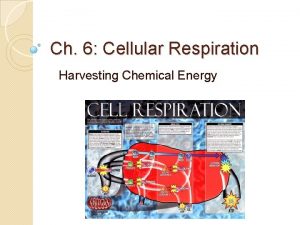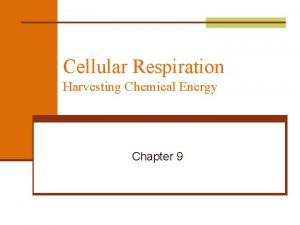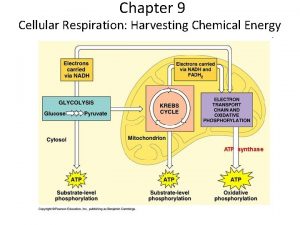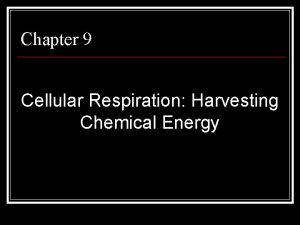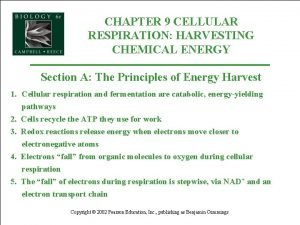CHAPTER 9 CELLULAR RESPIRATION HARVESTING CHEMICAL ENERGY Section

























- Slides: 25

CHAPTER 9 CELLULAR RESPIRATION: HARVESTING CHEMICAL ENERGY Section B: The Process of Cellular Respiration 1

Section B: The Process of Cellular Respiration 1. Respiration involves glycolysis, the Krebs cycle, and electron transport 2. Glycolysis harvests chemical energy by oxidizing glucose to pyruvate (in cytoplasm) 3. The Krebs cycle completes the energy-yielding oxidation of organic molecules (in motochonderial matrix) 4. The electron transport chain to synthesis ATP (inner mitochondrial membrane) 5. Cellular respiration generates many ATP molecules for each sugar molecule it oxidizes (38 ATP molecule) 2

Respiration involves glycolysis, the Krebs cycle, and electron transport • Respiration occurs in three metabolic stages: glycolysis, the Krebs cycle, and the electron transport chain and oxidative phosphorylation. • Glycolysis occurs in the cytoplasm. – It begins catabolism by breaking glucose into two molecules of pyruvate. Fig. 9. 6, Page 160 • The Krebs cycle occurs in the mitochondrial matrix. – It degrades pyruvate to carbon dioxide. • Several steps in glycolysis and the Krebs cycle transfer electrons from substrates to NAD+, forming NADH. • NADH passes these electrons to the electron transport chain. 3

• As electrons passed along the chain, their energy stored in the mitochondrion in a form that can be used to synthesize ATP via oxidative phosphorylation. – Oxidative phosphorylation produces almost 90% of the ATP generated by respiration. • Some ATP is also generated in glycolysis and in Krebs cycle by substrate-level phosphorylation. – Here an enzyme transfers a phosphate group from an organic molecule (the substrate) to ADP, forming ATP. • Ultimately 38 ATP are produced per mole of glucose that is degraded to carbon CO 2 and H 2 O by respiration. 4 Fig. 9. 7, Page 161

1 - Glycolysis (splitting glucose): harvests chemical energy by oxidizing glucose to 2 pyruvate 1. 2. 3. 4. 5. 6. 7. During glycolysis, glucose (a ( six carbon-sugar) is split into two molecules (each is three-carbon sugar). These smaller sugars are oxidized and rearranged to form two molecules of pyruvate. Each of the 10 steps in glycolysis is catalyzed by a specific enzyme. These steps can be divided into two phases: A)- Energy investment phase: ﺇﺳﺘﻬﻼﻙ ﻃﺎﻗﺔ ATP is consumed to provides activation energy by phosphorylating glucose (this requires 2 ATP per glucose). B)- Energy payoff phase: ﺇﻧﺘﺎﺝ ﻃﺎﻗﺔ ATP is produced by substrate-level phosphorylation and NAD+ is reduced to NADH. 4 ATP and 2 NADH are produced per glucose. Thus, the net yield from glycolysis is 2 ATP and 2 NADH per glucose. Glycolysis occurs in the absence of O 2, thus, No CO 2 is produced 5 Fig. 9. 8

Summary of Glycolysis (Splitting of glucose) Page 161 It is the process of breaking a glucose into 2 Pyruvate. It is a source for some ATP & NADH and occurs in the CYTOSOL (cytoplasm). It has two phases (See Fig. 9. 9, Page 162) A)- Energy investment phase 1)- Glucose is phosphorylated twice by adding 2 P coming from 2 ATP (substrate-level-phosphorylation). 2)- Thus, Glucose (6 -C) splits into two small sugar molecules (each with 3 -C). 6

Summary of Glycolysis (Splitting of glucose) B)- Energy pay-off phase See Fig. 9. 9, Page 163 3)- The two resulting 3 -C-sugars are then oxidized (losing 4)- The resulting e- (H)). e- from the two 3 -C-sugar are used for reducing 2 NAD+ into 2 NADH molecules via dehydrogenase. 5)- 4 ATP are formed by adding 4 P to 4 ADP molecules. 6)- The net yield of this process is the formation of 2 ATP 7)- Now and 2 2 NADH, pyruvate molecules. pyruvate is ready for Krebs Cycle. 7

2. The Krebs cycle completes the energy-yielding oxidation of organic molecules (in mitochondrial matrix): • If O 2 is present, pyruvate enters the mitochondrion where enzymes of the Krebs cycle complete the oxidation of this organic fuel to CO 2. • As pyruvate enters the mitochondrion which modifies pyruvate to acetyl-Co. A which enters the Krebs cycle in the matrix. – A carboxyl group is removed as CO 2. – A pair of electrons is transferred from the remaining two-carbon fragment to NAD+ to form NADH. – The oxidized fragment, acetate, combines with coenzyme A to form acetyl-Co. A. Fig. 9. 10, Page 164 8

2. The Krebs cycle completes the energy-yielding oxidation of organic molecules (in mitochondrial matrix): It is the process of producing some of the remaining energy from the Pyruvate molecules. It occurs mainly in mitochondrial matrix. It is the main source for preparing most of the cellular NADH (storing energy molecule), and for producing some more of the cellular ATP. It includes two cycles : Pre-Krebs cycle ﺍﻟﻤﺮﺣﻠﺔ ﺍﻟﺘﺤﻀﻴﺮﻳﺔ Krebs cycle 9

Fig. 9. 10, Page 164 A)- Pre-Krebs cycle Pyruvate is converted into acetyle-Co. A in the presence of O 2 through 3 steps - a)- C=O group of pyruvate is released as CO 2. e- b)- The remaining two-C fragments are oxidized (releasing ) into - transform NAD+ into NADH. acetate and the resulting e c)- The coenzyme-A (Co. A) transform acetate compound into acetyle -Co. A, which will be ready for Krebs Cycle for further oxidation. 2 NAD+ 2 Pyruvate 2 NADH + H+ Co. A 2 Acetyle-Co. A + CO 2 + H 2 O Krebs Cycle 10

B)- Krebs cycle It has eight steps starting with 2 acetyle. Co. A compunds. They are summarized as in Fig. 9. 12: • • • Pre-Krebs Cycle This cycle begins when acetate from each acetyl. Co. A combines with oxaloacetate (4 C atoms) to form citrate (citric acid). Ultimately, the oxaloacetate is recycled and the acetate is broken down to CO 2. Each cycle produces one ATP by substrate-level phosphorylation, three NADH, and one FADH 2 (another electron carrier) per acetyl Co. A. Thus, the outcome of the two cycles is (for the 2 Acetyle-Co. A molecules): 2 ATP Output 6 NADH 2 Flavin Adenine Dinucleotide Fig. 9. 12, Page 166 11

4. The inner mitochondrial membrane couples electron transport to ATP synthesis (90% of ATP) • Only 4 of 38 ATP ultimately produced by respiration of glucose are derived from substrate-level phosphorylation (2 from glycolysis and 2 from Krebs Cycle). • The vast majority of the ATP (90%) comes from the energy in the electrons carried by NADH and FADH 2. • The energy in these electrons is used in the electron transport chain to power ﻟﺘﺪﻋﻢ ATP synthesis. • Thousands of copies of the electron transport chain are found in the extensive surface of the cristae (the inner membrane of the mitochondrion). • Electrons drop in free energy as they pass down the electron transport chain. 12

• Electrons carried by NADH are transferred to the first molecule in the electron transport chain (the flavoprotein). ( • The electrons carried by FADH 2 have lower free energy and are added to a later point in the chain. • Electrons from NADH or FADH 2 ultimately pass to oxygen. • The electron transport chain generates no ATP directly. Rather, its function is to break the large free energy drop from food to oxygen into a series of smaller steps that release energy in manageable amounts ﻛﻤﻴﺎﺕ ﻣﻨﺎﺳﺒﺔ. • The movement of electrons along the electron transport chain does contribute to chemiosmosis ﺍﻟﺪﻓﻊ ﺍﻟﻜﻴﻤﻴﺎﺋﻰ (ATP synthesis process). Fig. 9. 13 13

• ATP-synthase, in the cristae actually makes ATP from ADP and Pi. • ATP used the energy of an existing proton gradient to power ATP synthesis. – This proton gradient develops between the intermembrane space and the matrix. – This concentration of H+ is the proton-motive force. • • The ATP synthase molecules are the only place that will allow H+ to diffuse back to the matrix. This flow of H+ is used by the enzyme to generate ATP a process called chemiosmosis. • Chemiosmosis: (osmos = puch) is the oxidative phosphorelation that results in ATP production in the inner membrane of mitochondria. 14 Fig. 9. 14

Energy of NADH and FADH 2 give a maximum yield of 34 ATP is produced by oxidative phosphorylation. Fig. 9. 15, Page 168 15

5. Cellular respiration generates many ATP molecules for each sugar molecule it oxidizes • During respiration, most energy flows from glucose -> NADH -> electron transport chain -> proton-motive force -> ATP. • One six-carbon glucose molecule is oxidized to 6 CO 2 molecules. • Some ATP is produced by substrate-level phosphorylation during glycolysis and the Krebs cycle, but most ATP comes from oxidative phosphorylation (through electron transport chain). • Each NADH from the Krebs cycle and the conversion of pyruvate contributes enough energy to generate a maximum of 3 ATP. • Each FADH 2 from the Krebs cycle can be used to generate about 2 ATP. • Energy produced in electron transport chain gives a maximum yield of 34 ATP by oxidative phosphorylation via ATP-synthase. 16

• Plus the 4 ATP from substrate-level phosphorylation (glycolysis & Krebs Cycle. ) gives a bottom line of 38 ATP. • Efficiency ﻓﻌﺎﻟﻴﺔ of generating ATP during cell respiration: – Complete oxidation of glucose releases 686 kcal/mole. – Formation of each ATP requires ﻳﺤﺘﺎﺝ at least 7. 3 kcal/mole. – Efficiency of respiration is: 7. 3 x 38 = 277. 4 Kcal – % of energy consumed for 38 ATP is: (277. 4/686)100 = 40%. – The other 60% is lost as heat. • Cellular respiration is remarkably efficient in energy conversion. 17

Summary of cell respiration 18 Fig. 9. 16, Page 169

Summary of Respiration - Glycolysis occurs in the cytosol and breaks glucose into two pyruvates - Krebs Cycle takes place within the mitochondrial matrix, and breaks a pyruvate into CO 2 and produce some ATP and NADH. - Some steps of Glycolysis and Krebs Cycle are Redox in which dehydrogenase enzyme reduces NAD+ into NADH. - Some of ATP is produced at these tow steps via (substrate-levelphosphorylation). - Electron Transport Chain accepts e- from NADH and passes these efrom one protein molecule to another. - At the end of the chain, e- combine with both H+ and O 2 to form H 2 O and release energy. - These energy are used by mitochondria to synthesis 90% of the cellular ATP via ATP-synthase, a process called Oxidative Phosphorylation, in the inner membrane of mitochondria. 19

Definitions: ﺗﻌﺮﻳﻔﺎﺕ Chemiosmosis: a process via which oxidative phosphorylation takes place at the end of the Electron Transport Chain to produce 90% of ATP via ATP-synthase: an enzyme presents in the inner mitochondrial membrane and used in making ATP by using H+ (protons). NAD+: Nicotinamide adenine dinucleotide, which is a co-enzyme that helps electron transfer during redox reactions in cellular respiration. FAD: Flavin adenine dinucleotide, which is an electron acceptor that helps electron transfer during Krebs Cycle and Electron Transport Chain in cellular respiration. 20

Fermentation enables ﻥ some cells to produce ATP without the help of oxygen • Oxidation refers to the loss of electrons to any electron acceptor, not just to oxygen. – In glycolysis, glucose is oxidized to two pyruvate molecules with NAD+ as the oxidizing agent, not O 2. – Some energy from this oxidation produce 2 ATP (net). – If oxygen is present, additional ATP can be generated when NADH delivers its electrons to the electron transport chain. • Glycolysis generates 2 ATP whether oxygen is absent (anaerobic )ﻻﻫﻮﺍﺋﻰ. • Anaerobic catabolism of sugars can occur by fermentation. • Fermentation can generate ATP from glucose by substrate-level phosphorylation as long as there is a supply of NAD+ (the oxidizing ( agent) to accept electrons. – If the NAD+ pool is exhausted ﺇﺳـﺘﻧﻔﺫ , glycolysis shuts down. – Under aerobic ﻫﻮﺍﺋﻰ conditions, NADH transfers its electrons to the electron transfer chain, recycling NAD+. • Under anaerobic conditions, various fermentation pathways generate ATP by glycolysis and recycle NAD+ by transferring electrons from 21 NADH to pyruvate.

• Alcohol fermentation: the pyruvate is converted to ethanol in two steps. – First, pyruvate is converted to acetaldehyde by the removal of CO 2. – Second, acetaldehyde is reduced by NADH to ethanol. – Alcohol fermentation by yeast is used in winemaking. • Lactic acid fermentation: the pyruvate is reduced directly by NADH to form lactate (ionized form of lactic acid). – Lactic acid fermentation by some fungi and bacteria is used to make cheese and yogurt. – Muscle cells switch from aerobic respiration to lactic acid fermentation to generate ATP when O 2 is scarce ﻧﺎﺩﺭ. • The waste product, lactate, may cause muscle fatigue, but ultimately it is converted back to pyruvate in the liver. 22 Fig. 9. 17 a & b, Page 171

• Fermentation and cellular respiration are anaerobic and aerobic alternatives, respectively, for producing ATP from sugars. – Both use glycolysis to oxidize sugars to pyruvate with a net production of 2 ATP by substrate-level phosphorylation. – Both use NAD+ as an electron acceptor. • In fermentation, the electrons of NADH are passed to an organic molecule, regenerating NAD+. • In respiration, the electrons of NADH are ultimately passed to O 2, generating ATP by oxidative phosphorylation. • In addition, even more ATP is generated from the oxidation of pyruvate in the Krebs cycle. • Without oxygen, the energy still stored in pyruvate is unavailable to the cell. • Under aerobic respiration, a molecule of glucose yields 38 ATP, but the same molecule of glucose yields only 2 ATP under 23 anaerobic respiration.

• • Some organisms (facultative anaerobes )ﺍﻟﻼﻫﻮﺍﺋﻴﺔ ﺍﺧﺘﻴﺎﺭﻳﺎ , including yeast and many bacteria, can survive using either fermentation or respiration. At a cellular level, human muscle cells can behave as facultative anaerobes, but nerve cells cannot. Fig. 9. 18, Page 171 Proteins and fats, can also enter the respiratory pathways, including glycolysis and the Krebs cycle, like carbohydrates. Fig. 9. 19, Page 172 24

The other two major fuels, proteins and fats, can also enter the respiratory pathways, including glycolysis and the Krebs cycle, used by carbohydrates. Carbohydrates, fats, and proteins can all be catabolized through the same pathways. 25 Fig. 9. 19, 172
 Chapter 9 cellular respiration harvesting chemical energy
Chapter 9 cellular respiration harvesting chemical energy Explain how amp stimulates cellular respiration
Explain how amp stimulates cellular respiration Chapter 9: cellular respiration: harvesting chemical energy
Chapter 9: cellular respiration: harvesting chemical energy Phosphorelation
Phosphorelation Chapter 8 section 3 cellular respiration
Chapter 8 section 3 cellular respiration What plant need for photosynthesis
What plant need for photosynthesis Formula for cellular respiration
Formula for cellular respiration What is the chemical formula of cellular respiration
What is the chemical formula of cellular respiration Chapter 8 section 1 how organisms obtain energy answer key
Chapter 8 section 1 how organisms obtain energy answer key What's cellular respiration
What's cellular respiration Section 3 cellular respiration worksheet answers
Section 3 cellular respiration worksheet answers Section 3 cellular respiration
Section 3 cellular respiration Section 3 cellular respiration continued
Section 3 cellular respiration continued Energy flow in cellular respiration
Energy flow in cellular respiration Energy flow in cellular respiration
Energy flow in cellular respiration Cellular respiration obtaining energy from food
Cellular respiration obtaining energy from food Cellular respiration obtaining energy from food
Cellular respiration obtaining energy from food Chapter 8 section 2 photosynthesis
Chapter 8 section 2 photosynthesis Redox reaction in cellular respiration
Redox reaction in cellular respiration The gray-brown haze often found over large cities is called
The gray-brown haze often found over large cities is called Chemiosmosis steps
Chemiosmosis steps Types of respiration
Types of respiration Fermentering
Fermentering Why is cellular respiration important
Why is cellular respiration important Complimentary processes
Complimentary processes Cellular respiration reactants
Cellular respiration reactants



